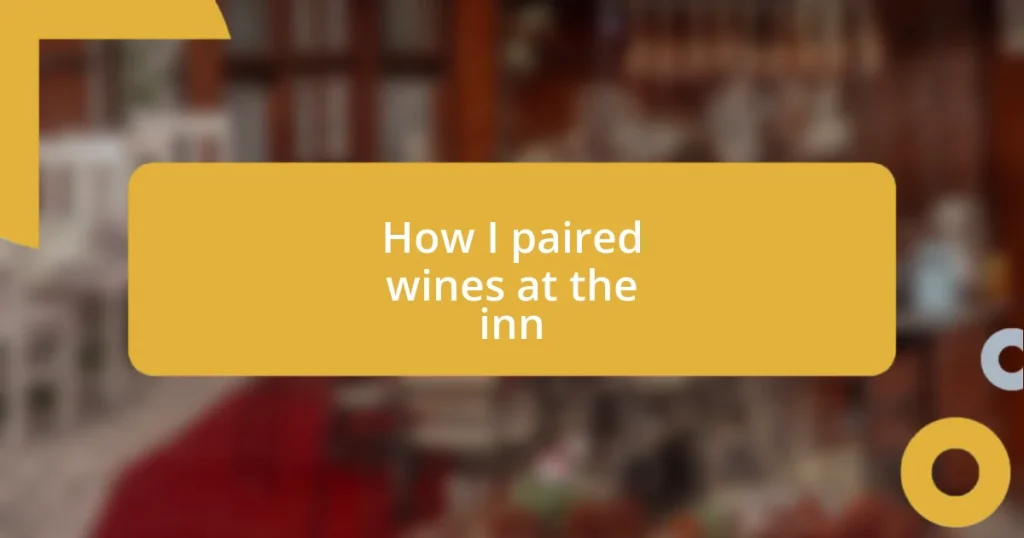Key takeaways:
- Understanding wine involves appreciating how factors like grape variety, soil, and weather influence its flavor, enhancing the tasting experience.
- Selecting the right wine depends on personal taste, the dish’s body, and flavor profile; ensuring harmonious pairings can elevate meals and gatherings.
- Common mistakes in pairing include disregarding the food’s flavor and being overly strict with pairing rules; experimentation can lead to delightful discoveries.

Understanding wine basics
Wine can be quite the adventure, can’t it? I remember the first time I tasted a Pinot Noir; the earthy notes made me feel like I was wandering through a sun-dappled forest. Understanding the basics of wine helps set the stage for these delightful experiences. It’s not just about different grape varieties; it’s about how soil, weather, and even winemaking techniques influence the flavors that dance across your palate.
Swirling a glass of wine releases its aromas, but it also helps you appreciate the structure—the balance of sweetness, acidity, and tannins. When I first learned to pair wine with food, I marveled at how a robust Cabernet Sauvignon could transform a simple steak dinner into an extraordinary experience. This interplay between food and wine is a dance of flavors. Have you ever felt a particular wine elevate a meal you were enjoying? That’s the beauty of understanding these basics; it opens up a world where each sip can spark a different emotion or memory.
Tasting wine is a sensory journey, but knowing the components—body, acidity, sweetness, and tannins—provides a framework for this exploration. I often find myself asking, “Does this wine match my mood today?” and discovering that the right choice can make me feel relaxed or invigorated. Isn’t it amazing how a glass can encapsulate so much more than just a beverage? By grasping these fundamentals, you can start to uncover your own preferences and truly savor every moment.

Selecting the right wines
Selecting the right wines involves understanding personal taste and the characteristics of each wine. I recall a dinner party where I decided to serve a creamy Chardonnay alongside a rich pasta dish. The warmth of the wine perfectly complemented the meal, and I’ll never forget the smiles that spread across my friends’ faces as they took their first sips. It’s this kind of alignment between wine and food that truly elevates a gathering.
When considering a selection, think about the wine’s body and flavor profile. Light-bodied wines, like Sauvignon Blanc, usually pair better with lighter dishes, such as salads or seafood, while fuller-bodied reds like Malbec can enhance the depth of heavier fare, like braised meats. I learned this the hard way during an ambitious cooking night when I paired a bold Shiraz with a delicate fish dish—let’s just say the pairing didn’t quite hit the mark.
Reflecting on the occasion, it’s crucial to consider your guests’ preferences. I often find that asking everyone about their favorite wines can spark some delightful conversations and make the selection process more engaging. This simple dialogue not only helps in picking a diverse range of wines but also creates a more inclusive atmosphere for everyone to enjoy.
| Wine Type | Suggested Pairing |
|---|---|
| Sauvignon Blanc | Light salads, seafood |
| Chardonnay | Rich pasta dishes |
| Shiraz | Grilled meats |
| Malbec | Hearty braised dishes |

Pairing wines with food
Pairing wine with food is a delightful journey that brings out the best in both. I still remember a cozy winter evening when I paired a smooth Merlot with a hearty mushroom risotto. The velvety texture of the wine beautifully matched the creaminess of the dish, creating a warmth that enveloped us like a favorite blanket. Discovering the right pairing feels like uncovering a secret recipe for joy.
To elevate your own pairing experiences, consider these insights:
– Match body with body: Bold wines with rich dishes, and lighter wines with delicate flavors.
– Think about acidity: A zesty white can brighten fatty foods, while acidic reds can cut through the richness of meats.
– Type of cuisine matters: Pair Italian wines with Italian dishes; it often feels like a natural fit.
– Texture is key: Creamy wines work wonders with creamy sauces, making the whole experience delightful.
One afternoon, I experimented with a fruity Rosé alongside a fresh summer salad adorned with strawberries and goat cheese. The burst of flavors was like summer on a plate, and my guests were so enchanted that the laughter around the table echoed long after the last glass had been raised. Embracing these principles transforms simple meals into remarkable experiences.

Considerations for seasonal pairings
When I think about seasonal pairings, I find that the change in temperature affects not only my mood but also the dishes I crave. For instance, in the fall, I love to pair a warming Cabernet Sauvignon with roasted root vegetables and rich meats. The robust flavors of the wine bring out the sweetness of the roasted veggies, creating a symphony of taste that feels like a comforting hug against the crisp autumn air.
As the seasons shift, so does the availability of fresh ingredients, which is essential to consider. In the summer, I often reach for a chilled Pinot Grigio to complement grilled fish or zesty salads bursting with fresh herbs. The lightness of the wine enhances the brightness of the meal, and I can’t help but smile when I see my friends indulge in these vibrant flavors. Have you ever experienced how the right wine can instantly transport you to a sunny patio, even when the skies are cloudy?
Winter, on the other hand, invites heartier fare and deeper wines. I vividly recall a snowy evening spent with friends around a roaring fire, where I paired a bold Zinfandel with beef stew. The wine’s spiciness mirrored the dish’s rich flavors, creating a warm and cozy atmosphere. It’s moments like these, where both food and wine reflect the season’s essence, that remind me of the magic of thoughtful pairings.

Serving and presentation tips
To enhance the overall experience of serving wine, presentation plays a pivotal role. I still recall a dinner party where I decanted a rustic red into a beautiful glass carafe. The gentle pour released its bold aromas, and watching my guests’ eyes light up as I offered the first glass felt incredibly rewarding. Presentation elevates the occasion, turning a simple meal into something memorable.
When it comes to temperature, I’ve discovered that the right chill can make all the difference. A crisp Sauvignon Blanc, served just cold enough, can invigorate a palate, especially on a warm day. I often keep a chilled bottle at hand during summer gatherings; it’s a surefire way to keep the vibe light and refreshing. Have you ever noticed how the right temperature can enhance a wine’s flavor? It really is transformative.
Finally, the choice of glassware can impact not only the aesthetic but also the tasting experience. I personally prefer using specific glasses tailored for different types of wine—like wider bowls for reds and narrower shapes for whites. Recently, I hosted a casual tasting session with friends and swapped glasses for each wine we tried. Everyone was surprised at how much the shape could change the aromas! It turned our evening into an engaging exploration of flavor and nuance, making every sip an adventure.

Common pairing mistakes to avoid
When it comes to wine pairing, one common mistake I often see is focusing solely on the wine instead of the food. I remember eagerly choosing a robust Malbec for a spicy Thai curry, only to realize the flavors clashed rather than complemented each other. That experience taught me the importance of considering the dish’s seasoning and spice level; not every wine will shine alongside every cuisine.
Another pitfall is skipping the balance between flavor intensities. I once served a delicate white wine with a bold, creamy risotto, thinking the two would be harmonious. Instead, I found the wine overwhelmed by the dish. It’s crucial to ensure that the wine and food can stand up to each other—pair lighter wines with lighter dishes and more intense wines with heartier fare. What’s the point of a perfect meal if the wine gets lost in the mix?
Lastly, I can’t emphasize enough the mistake of being too rigid with pairing “rules.” For instance, I had a casual dinner where I boldly paired a sweet Riesling with a savory cheese platter. Instead of the expected discord, the unexpected pairing sparked delightful conversations among my friends! So, don’t shy away from experimenting; some of the best culinary memories come from breaking the rules and discovering surprising harmonies. Have you ever tried a pairing that defied convention and left you pleasantly surprised?

Enhancing guest experiences with wine
The right wine can turn an ordinary meal into an unforgettable experience. I remember a cozy winter evening when I paired a rich Cabernet Sauvignon with a hearty stew. As each guest savored their first sip, the warmth of the wine mirrored the comfort of the meal, creating an atmosphere of shared delight. Have you ever felt that magic when everything on the table just seems to click?
It’s fascinating how wine can ignite connections among guests. One time, during a small gathering, I introduced a lesser-known, fruity Grenache that sparked a lively discussion about its origin and flavor profile. The conversation flowed seamlessly, as everyone leaned in, eager to share their thoughts. I find that a well-chosen wine can be a conversation starter, inviting guests to engage and bond over a shared discovery.
Even the simplest gatherings can be transformed with thoughtful wine pairings. I once decided to serve a crisp Prosecco at an impromptu barbecue, surprising my friends who expected beer instead. Watching their expressions shift from curiosity to enjoyment as they experienced the bubbly with grilled shrimp made me realize the impact of unexpected choices. Does it make you wonder how altering one element, like the wine, can change the entire vibe of an event? It truly does!















